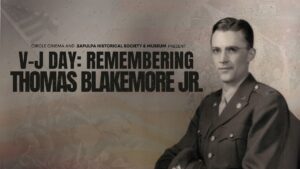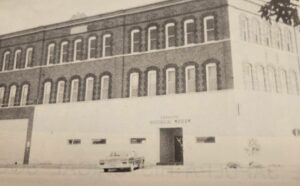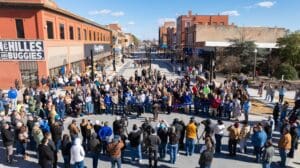Rachel Whitney, Curator, Sapulpa Historical Museum
Fire! Fire!
Shouting in the streets.
People, horses, wagons, rushing to the fire, away from the fire, and hurrying out of the way.
Firefighters rushing, ringing the bell, churning the alarm, making their way to the fire.
Fire! Fire!
That was one of the ways to call the fire department, by shouting in the street, passing the message along down the way, and the firefighters made their way to the scene. New ways of communication would be introduced to further safety precautions.
When telephones were introduced, many homes and businesses did not have one, but still the first responders needed to find their way to the scene. In Sapulpa, it was announced in 1909 that Sapulpa would be introducing another safety precaution – Gamewell Fire Alarm Boxes.
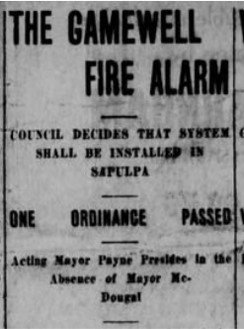
City council discussed “matter of importance was the acceptance of a proposition upon the part of the Gamewell Fire Alarm and telegraph company to install a fire alarm system in the city. It is understood that the installation of this system probably will cost $5,000.”
In 1909, the $5,000 would roughly be over $150,000 in today’s inflation value.
The era of fire alarm boxes began in Sapulpa. Gamewells would be posted on telephone poles in the downtown. Citizens could operate the fire alarm box and direct the firefighters to the fire. Gamewells would have a designated number to each location. Once the glass was open, the door was opened, and this sent a signal to the fire department. The Gamewell number told where the firefighters needed to rush to.
This week in Sapulpa history, in 1921, the city had 50 fireboxes displayed, half of which were installed this week in February. “One valuable step toward fire prevention is the placing of 26 additional alarm boxes on the already extensive call circuit of the fire department, completed last week.”
With the fire boxes, “citizens are urged to study the list and learn where the nearest firebox to their property is located.” The newspaper listed the fire box locations by their corners.
By the end of the year, another precaution would be installed. This would include the Sapulpa Police Department.
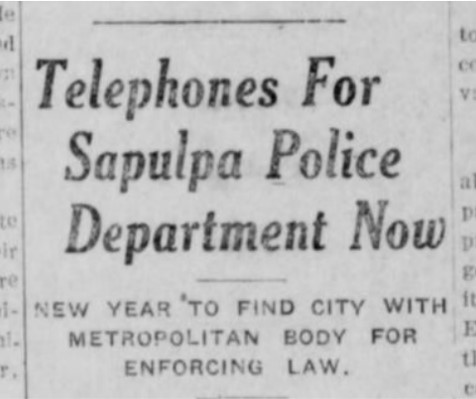
“Telephones for Sapulpa Police Department ” now were being installed. The police call boxes in Sapulpa would be similar to the fire alarm boxes, but for use from the police officers only.
“Sapulpa will soon have all of the accouterments which go to make up a metropolitan police department – a police telephone system to be the next one added. The downton policemen have been in uniform for some time. Now a new, regulation patrol wagon is ready to be placed in operation on the streets. Next is coming patrol boxes which will be placed over the city so that policemen can telephone directly to the station. There are from ten to fifteen of the boxes. Chief Morey now requires that each policeman call into the station every hour – a system used in all big cities. When the patrol boxes are installed he will require that they call from them, so that officer’s locations in the city will be exactly known.”

Similarly to the fire alarm boxes, “a modern switchboard of an unusual type has been installed. It has ticket tape, on which is stamped the hour and date of the call telephoned to the station. Dots are also punched into the paper tape to show the number of the box from which call comes. For example: if it is box number 23, there are two dots punched in the tape and then a row of three dots. By writing the name of the policeman making the call on the tap, along with the dots, the time and date, a complete record of the day’s telephone calls is kept on the tape. This saves bookkeeping on the regular calls made by police.”
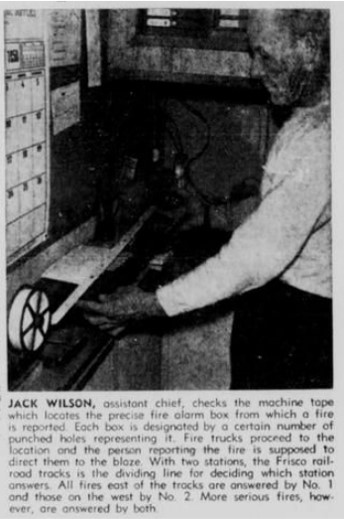
An additional feature would be included on the call boxes. “A policeman can ‘call the wagon’ by simply inserting his key and giving it a certain twist. This punches one dot in front of the box number on the tape. Not having to open the box and telephone is often a great help when a policeman has an unruly prisoner.”
With the installation of the call boxes and alarm boxes, it kept Sapulpans safe in case of an emergency. These installations were like the ones in the big cities, and Sapulpa kept up with the times and updates. Sapulpa’s system was even larger than the city commissioners themselves even realized.
In April 1926, “Sapulpa’s fire alarm system is a whole lot larger than the average Sapulpan think it is. The commissioner replied that he ‘supposed there were ten or fifteen’” boxes in town. Chief Collier “immediately corrected the supposition and informed the commissioner and the Herald that there were fifty-five boxes in various parts of the city.”

The article listed not only where the call boxes were located, but their box numbers, as well. For instance “box no. 12-Hobson and Main…box no. 35-McLeod and Mission…box no. 45-Schram Glass Plant…box no. 214-Dewey and Oak…”

However, soon, times would change, not only in Sapulpa or the country, but around the world. The Great Depression affected individuals, households, business owners, businesses, and operations, including departments.
The boxes ceased to operate for the need of material was a greater need than ever. “Sapulpa at one time had fire alarm boxes downtown but took them out before the war because of lack of materials and wire to service them.”
The world went to war, and materials were scrapped and needed. But the end of World War II brought in a new idea of standards and regulations. In 1947, it was announced once again, Sapulpa would install fire alarm boxes. “Installation of downtown fire alarm boxes was underway today by the fire department in another step toward qualifying Sapulpa for Sixth Class Rating when over-all program is finished in about 18 months, according to Fred Brawner, city manager. At present time, Sapulpa is in the Seventh Class.”
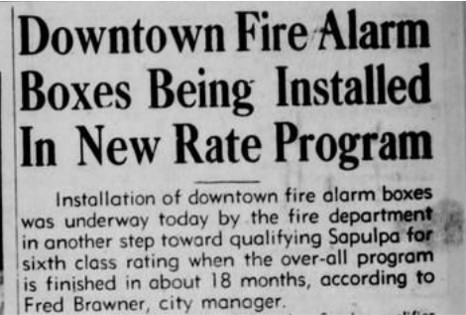
New and improved equipment would be installed all over the city. “The city manager estimated that when Sapulpa qualifies for Sixth Class, it will mean a saving of about $25,000 in fire insurance premiums for Sapulpans.”
The article mentioned where the newest boxes would be installed: “on a post at Main and Lee, near the St James Hotel; one on the side of the building a the old Chamber of Commerce rooms located at Main and Dewey, near the alley; one on a post at Water and Lee; one on Newberry’s store on Dewey Ave near the alley; one on the Clayton Building; one at Park and Lee on a pole; one on Elm on a pole at the post office; one on Haston’s second-hand store, located at the alley on Dewey in the 300 block; one on Naifeh’s wholesale building on Hobson between Park and Oak; one on a post by the Norwood Hotel, Hobson and Water.”
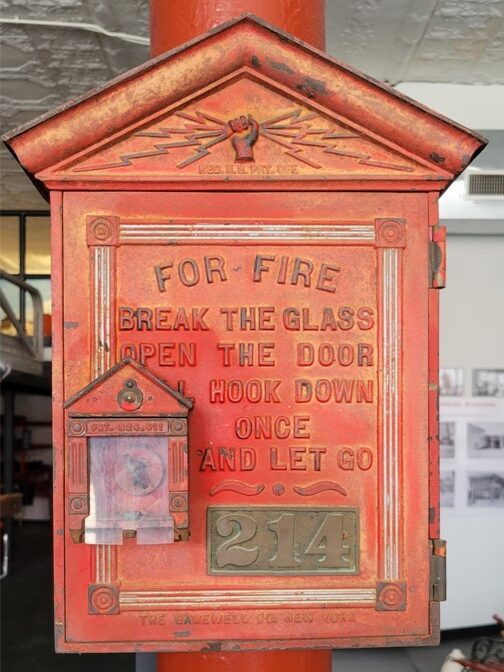
It is uncertain how many of the newest fireboxes would be installed after 1947. However, the call boxes were still in operation until the 1960s. In 1964, it was announced: “The Gamewell fire alarm system, characterized by the red boxes with ‘break the glass in case of fire’ motto, have been abandoned by the city, according to city manager, Max Minor. The detection devices have been put out of service due to the unpredictable behavior they have shown when used for fire reporting.”
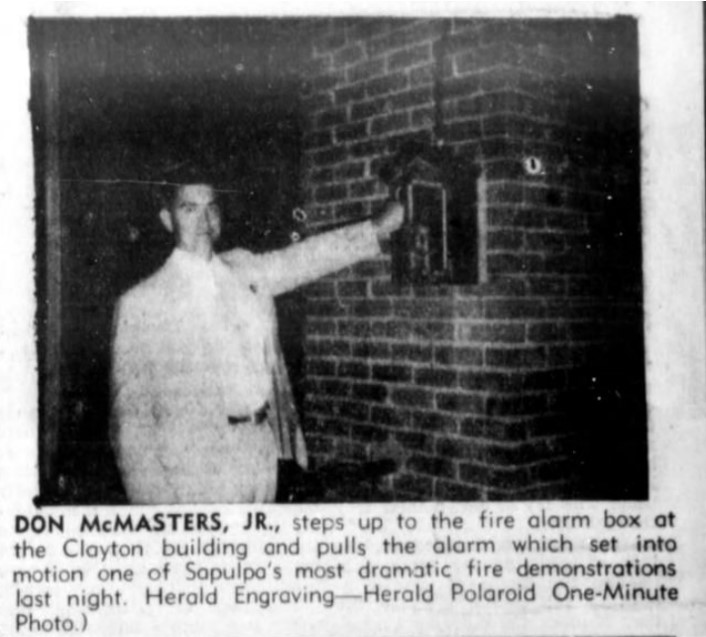
Fire Chief Lem Rhodes and his crew began dissecting and removing the call boxes around town. The last box to be removed was on the corner of Park and Lee.
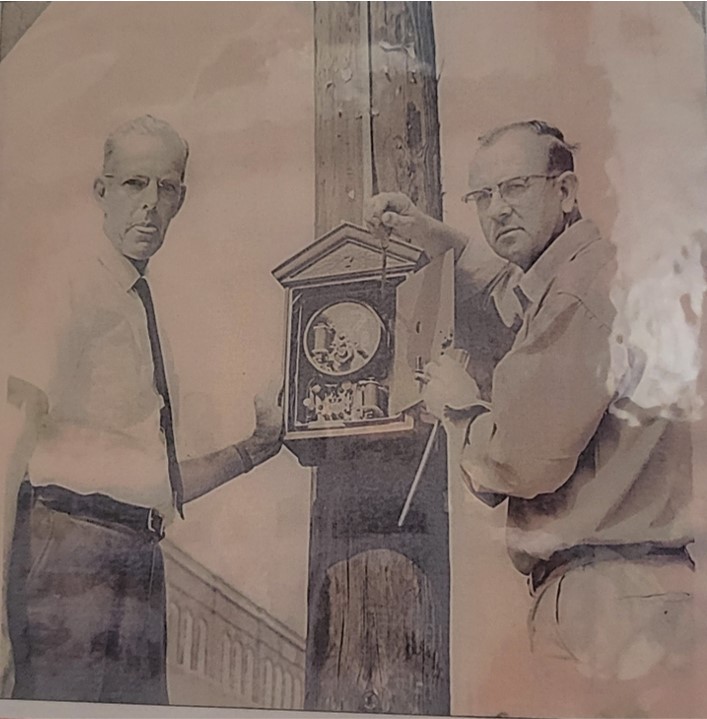
(Sapulpa Light, December 2, 1909; Sapulpa Herald, January 8, 1921, February 12, 1921, December 31, 1921, March 17, 1922, April 30, 1926, April 26, 1947, May 11, 1958; Sapulpa Daily Herald, October 9, 1953, July 9, 1964)



